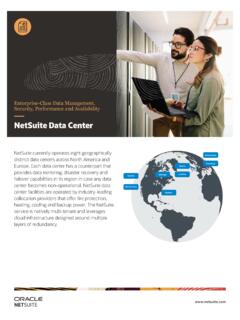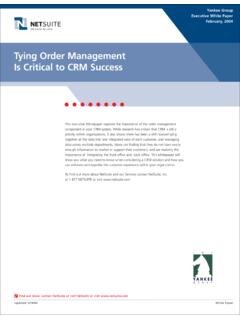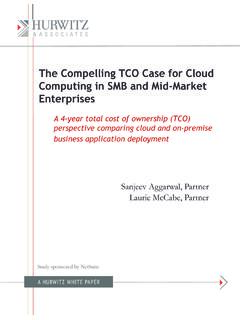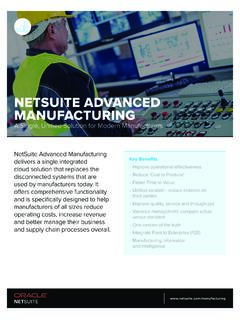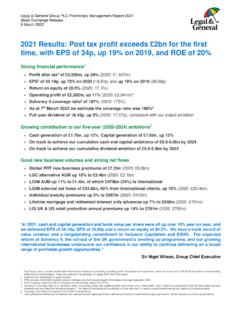Transcription of Due Diligence Checklist - NetSuite
1 Due Diligence Checklist This is a non-exhaustive list of information and documentation that will be needed in the due Diligence process. As each investigation will differ in terms of needed materials, the below can serve as a preparatory guide. What is Due Diligence ? Due Diligence is an essential process utilized by companies and private equity firms to evaluate a potential merger or acquisition. Buyers will conduct due Diligence on a target company to confirm the accuracy of the seller s claims, mitigate risk and garner deep insight into the operations prior to committing to the deal.
2 While the investigative process is painstakingly extensive, can help prevent costly surprises later on and increase the chances of M&A success. GET OUR PRIMER HERE. What Should I Include in a Due Diligence Checklist ? General information Examines general records and the business plan to understand the corporate structure and standing of a company. This broad initial step sets the stage for the more in-depth and targeted due Diligence investigation. Articles of incorporation Corporate bylaws and any amendments Minute book (containing ownership and board meeting minutes).
3 Certificate of Good Standing List of subsidiaries and any other entities in which the company has an equity interest ( partnerships and joint venture agreements) All jurisdictions where the company is authorized to conduct business Any documents relating to reincorporation or restructuring Business plan (executive summary, market analysis and plan, operational plan and complete financials) Organization and ownership information Delves into the structure of a company from a personnel perspective. The organizational due Diligence phase provides perspective surrounding the ownership of the business, which will be critical to consider when acquiring or merging with a company.
4 List of officers and directors Organization chart Records surrounding issuances or grants of stock, options and warrants List of all shareholders o Include number of shares, dates of issuance and type of consideration received Documentation of past and current shareholder agreements, rights, and other matters concerning ownership o Copies of any voting agreements, trusts or proxies o Copies of right of first offer or refusal and preemptive rights o Transfer restriction agreements and registration agreements Administrative Administrative due Diligence confirms administrative information about a company, like the business facilities, occupancy rate and number of workstations.
5 List of all business locations o Where the company owns/leases property, maintains employees and/or conducts business o Include applicable details like the occupancy rate and number of workstations Regulation and compliance This part of the due Diligence stage assesses regulatory or compliance issues with the target company or the overall deal. This process is particularly important in heavily regulated industries or with large parties in play. Look in particular for any antitrust risks the deal may present. Copy of the company s compliance policy and written standards of conduct Copies of any governmental licenses, permits or consents Any correspondence, citation, notice or documents relating to any proceedings of any regulatory agency Any documents filed with the SEC or any state or foreign securities regulatory agency (if applicable) Any material reports to government entities and agencies (including the EPA and OSHA) Analysis of potential antitrust issues (if applicable)
6 Accounting/Financial Confirms seller s financial performance by examining both accounting and financial documentation. The objective here is to identify any unreported liabilities, understand the target s current financial position and determine if earnings are sustainable. These activities help ensure a realistic valuation of the target and justification of the purchase price. Documentation surrounding the capitalization of the company Three years of annual and quarterly audited financial statements, with the auditor s reports Unaudited financial statements for comparison Latest interim financial information Future financial projections Descriptions of strategic plans Budget plan Any auditor communication to management for the past five years Schedule of accounts receivable and accounts payable A description of depreciation and amortization methods and changes in accounting methods over the past five years.
7 Copy of the company s general ledger Copies of any debt financing documents ( loan agreements, credit agreements, promissory notes, compliance certificates, etc.) Copies of any equity financing documents ( stock purchase agreements, subscription agreements, etc.) List of internal control procedures Schedule of any deferred revenue Operational Operational due Diligence examines the target company s systems and processes to identify risks arising from execution of the business function. Here, buyers assess the effectiveness of the target s operating model including sales, marketing, technology, supply chain and production to determine gaps and potential areas where investment or development are needed.
8 The goal is to see if the current state of operations can support the business plan provided by the target company. Overview of company s operating model showing key systems and processes (both insourced and outsourced) Description of the change management process when a change to the operating model is needed Copies of any documented procedures Overview of the organizational / functional structure of the teams List of company s primary and support activities A summary any tests, evaluations, studies, surveys, and other data regarding existing and under development products/services Identification of key performance indicators, value drivers and cost drivers Information around sales and marketing procedures, including research, messaging.
9 CRM systems and processes, and lead generation practices List of all third parties in the supply chain A breakdown by manufacturing site of the products manufactured, personnel employed, number of shifts and capacity Documentation around supply chain processes ( delivery times, inventory availability, transportation mode/costs, facility costs, inventory investment, contract manufacturers, etc.) List of main suppliers and their discounts, terms and credit limits Details around distribution model and channels Tax Delves into the target s tax profile by analyzing tax returns and the company s tax structure.
10 Tax examination is a highly emphasized area of due Diligence , as the acquiring company will be liable for any tax issues it inherits. Federal, state, local and foreign income tax returns for the last three years State sales tax returns for the last three years Excise tax filings for three years Employment tax filings for past three years Documentation around tax structure and key tax elections Any audit adjustments proposed by the IRS Documentation around any tax liens or settlements Copies of any audit and revenue agency reports Legal Reviews the legal matters facing a company and related risk around contracts or litigation.
